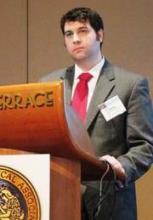MADISON, WIS. – Nearly one-fifth of all patients referred for parathyroidectomy were misdiagnosed with primary hyperparathyroidism in a retrospective study of 324 consecutive patients.
Notably, many of these patients had undergone comprehensive work-ups prior to surgical referral that clearly diagnosed secondary hyperparathyroidism.
"This demonstrates that there’s a prevalent misunderstanding of parathyroid pathophysiology," Dr. James Iannuzzi said at the annual meeting of the Central Surgical Association. "In particular, vitamin D deficiency accounted for the majority of misdiagnosis."
Using ICD-9 codes for hyperparathyroidism, benign, or malignant parathyroid tumors or hypercalcemia, the authors identified 381 patients who were referred to the endocrine surgery division at the University of Rochester (N.Y.) Medical Center between 2008 and 2011 for parathyroidectomy. Primary hyperparathyroidism (HPT) was defined by a calcium level of at least 10 mg/dL plus a parathyroid hormone (PTH) level of more than 50 pg/mL. Thirty patients were excluded for renal failure and 27, for coding errors.
Among the remaining 324 patients, 264 were correctly diagnosed and 60 (18.5%) were misdiagnosed with primary HPT, said Dr. Iannuzzi, a general surgery resident at the university. Fifty-four (90%) of the misdiagnosed patients had secondary HPT at the time of the referral. For 43 patients, this was clear at the time of referral, and 11 had secondary HPT as their sole diagnosis after follow-up. Six patients had hypercalcemia but not HPT. Half of the hypercalcemic patients were referred after a single spuriously elevated calcium level, only to have their calcium drop to normal levels after follow-up, he said.
Most of the 54 patients with secondary HPT had vitamin D deficiency (37 patients). Other causes were gastric bypass (4 patients), celiac disease (2 patients), and unclear etiology (11 patients). Mean calcium and PTH levels among patients with secondary HPT were 9.3 mg/dL and 92 pg/mL, respectively.
In all, 42 (70%) of the 60 misdiagnosed patients underwent inappropriate localized imaging, of which 57% were falsely positive.
"These studies are not indicated; likely to be falsely positive, as we show; and cause patients and referring physicians to more aggressively push for unindicated and potentially harmful surgery because of a finding on a scan," Dr. Jacob Moalem said in an interview. Dr. Moalem, an endocrine surgeon at the University of Rochester, was the senior author of the paper.
Part of the problem is that ultrasound is highly user dependent, and sonographers can be easily misled by exophytic nodules, hypoechoic structures that were subcentimeters, or lymph nodes. Sestamibi scans in this clinical setting also are likely to be positive because of the activated mitochondria. Thus, it is very important that the pretest diagnosis be correct, Dr. Moalem and Dr. Iannuzzi stressed.
Many patients were found to have an elevated PTH during evaluation for symptoms that could have been consistent with primary HPT. Such symptoms were present in 46 of the 60 misdiagnosed patients, the majority of which were from nephrolithiasis (22 patients), he said. Also relevant were bone loss in 15 and vague symptoms such as fatigue or depression in 11.
Although surgery may seem like a simple solution for patients who have an elevated PTH level, symptoms, and positive imaging findings, the operation can be harmful for those with secondary HPT because they’re dependent on increased PTH levels to maintain calcium homeostasis, Dr. Iannuzzi said. Parathyroidectomy is associated with 95%-98% cure rates for primary HPT, but patients with secondary HPT are unlikely to have an intraoperative drop in PTH levels. As a result, they often undergo a bilateral neck exploration that predisposes them to nerve injury. More importantly, if the parathyroid tissue they’re dependent on is removed, it may create irreversible hypoparathyroidism.
"Vigilance is absolutely necessary to avoid unindicated and potentially harmful surgery," Dr. Iannuzzi cautioned.
Invited discussant Dr. Herbert Chen, chair of general surgery and leader of the endocrine oncology group at the University of Wisconsin in Madison, said that the results underscore the role of surgeons as diagnosticians.
"This finding really emphasizes that as surgeons we are not merely technicians operating at the whim of our referring physicians, but have a responsibility to lead in the diagnostic phase of patient care," he said.
Those thoughts were echoed by fellow discussant Dr. Allan Siperstein, chair of endocrine surgery at the Cleveland Clinic, who also asked what lab panels are used to assess patients with mild hyperparathyroidism. Dr. Iannuzzi said that they use an extensive panel including ionized calcium, magnesium, phosphorus, vitamin D, and urinary calcium. Dr. Moalem emphasized that the diagnosis of primary HPT must be made based on simultaneously high or high-normal calcium and PTH measurements. Imaging studies have no role in making or refuting the diagnosis and should be used to guide the operative approach only when the diagnosis of primary HPT has been definitively established.



